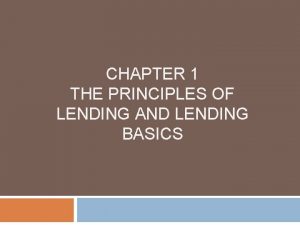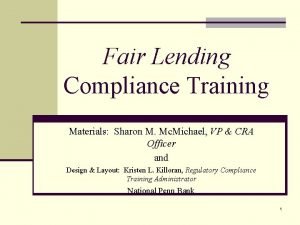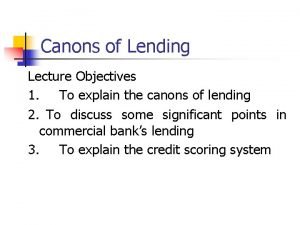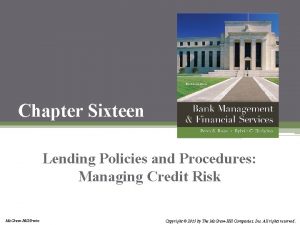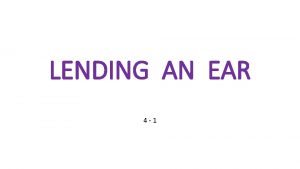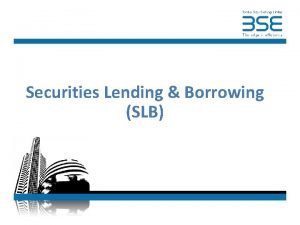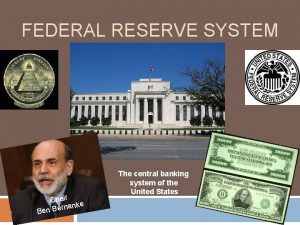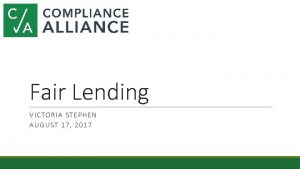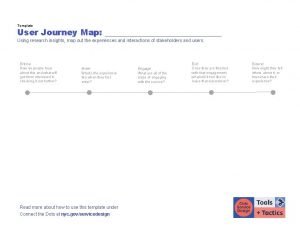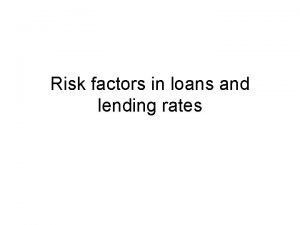Principles Of Lending Principles of Lending 1 Safety



























- Slides: 27

Principles Of Lending

Principles of Lending 1. Safety: � When a loan or investment is made, the banker will have to ensure that the money advanced is returned by the borrower with interest within the described time period. �This is only when the borrower does not face any risk and strictly stick to the terms of loan. �For this, the banker will have to chose such types of borrowers who are prompt in payment of the principle and interest amount.

2. Diversification of Risk: �The banker should aim at spreading the advances as widely as possible over different industries and different localities. �Dispersal of advances is very necessary from the point of security as well because it reduces the risk of recovery.

3. Remuneration: The banker need sufficient earnings to meet the following besides others: � Salaries and benefits to payables staff � Payments of dividends to shareholders � Return payable to money deposited with it

4. Liquidity: � The banker while making advances must see that the lended money is not going to be locked up for a long time which should make his loans and advances less liquid and more difficult to realize in cases of emergency.

5. Security: • The banker should ensure the policy that the borrower has the ability and will to repay the advances as per agreement. if it is insecure advance then payment depend upon the credit worthiness of borrower and that of the guarantor wherever applicable.

Forms Of Lending 1. Overdraft Loans 2. Cash Finance 3. Bridge & Participant Loan 4. Purchase & Discounting of Bills

1. Overdraft loans Overdraft as a useful tool in banking

Overdraft Loans �An overdraft is an extension of credit from a lending institution when an account reaches zero. An overdraft allows the individual to continue withdrawing money even if the account has no funds in it or not enough to cover the withdrawal. Basically, overdraft means that the bank allows customers to borrow a set amount of money.

Reasons for overdrafts �Intentional loan – The account holder finds himself short of money and knowingly makes an insufficientfunds debit. He accepts the associated fees and covers the overdraft with his next deposit. �Failure to maintain an accurate account register – The account holder doesn't accurately account for activity on his account and overspends through negligence.

Continue. . �Bank fees – The bank charges a fee unexpected to the account holder, creating a negative balance or leaving insufficient funds for a subsequent debit from the same account. �Victimization – The account may have been a target of identity theft. The criminal act could cause an overdraft or cause a subsequent debit to cause one. The money or cheques from an ATM deposit could also have been stolen or the envelope lost or stolen, in which case the victim is often denied a remedy.

Disadvantages of overdrafts Disadvantages include: �there will usually be a charge if you want to extend your overdraft. �you could be charged if you go over your overdraft limit. �the bank can ask for the money back at any time. �you can only get an overdraft from the bank that you hold your business current account with.

Overdraft Protection As A Useful Tool �Overdraft protection provides you with a valuable tool to manage your checking accounts. However, banks charge a fee and make money from this service; make sure you use the overdraft protection sparingly and only in an emergency situation.


2. Cash Finance Definition • “A form of financing in which the loan is backed by a company's expected cash flows. This differs from an asset-backed loan, where the collateral for the loan is based on the company's assets. ”

Cash Finance • It includes loans that are taken in times of urgent need of cash. • Cash finance loans are mostly unsecured loans and therefore do not need any collateral. • If the borrower has an existing relationship with the bank or other lending institution, it can be easier to get such loans.

Benefit s Cash financing is extended for a shorter period of time in most cases, and therefore, the overall interest cost might not be very high. Such lending is generally not dependent on the borrower's credit profile. Repaying cash finance loans on time can help borrowers improve their credit profile.

3. Bridge and participant loan Bridge loan , participant loan

Bridge and participant loan: �A bridge loan is a short-term loan that is used until a person or company secures permanent financing or removes an existing obligation. � The loans are short-term (up to one year) with relatively high interest rates and are backed by some form of collateral such as real state or inventory.

Bridge loan: �It is called a bridge loan because it serves as a bridge between one period of funding and another, more permanent source of funding. �Bridge loans are typically more expensive than conventional financing, to compensate for the additional risk.

Participant loan: �Collaboration among lenders to share in a loan (or a package of loans too big to handle for any one of them. Such loans called participation loan. �Participations” in the loan are sold by the lead bank to other banks. �. Such senior/subordinated loan participations can be structured either on a LIFO (Last In First Out) or FIFO (First In First Out) basis.

Continue. . . �Loan participations can either be made with equal risk sharing for all loan participants, or on a senior/subordinated basis, where the senior lender is paid first and the subordinate loan participation paid only if there is sufficient funds left over to make the payments.

4. Purchase And Discounting of Bills Ø There also bill drawn with a credit period which are payable after the credit period. Banks lending such receivable is called Discounting. Ø The banks deducts the interest for credit period and release the balance is also known as “ discounting the bill”

Continue… Ø The bank will become the holder a and owner of the bills. Ø If the drawer of the bill does not want to wait until the due date of the bill, and need of money , he may sell his bill to the bank at the certain rate of discounting. Ø The bill will be endorsed by the drawer with a signed and dated order to pay the bank.

Advantages of Discounting bills �It allow entrepreneur to do business without funds. �This work like a bank overdrafts, the borrowers pays the interest, only on the amount of money utilized. �There are borrowers who even cover the risk of bad debt along with the service. Obviously, the charge may be little more

Disadvantages of Discounting Bills �It can be an expensive form of financing compared to other modes of financing such as bank overdraft etc. �In many countries like India, where the central bank encouraged the scheme of bill discounting and allowed a lower percentage of interest. But, it was not successful due to various misuses by financing brokers, banks etc.

Bill Discounting Process �The process of bill discounting is simple and logical. �The seller sells the goods on credit and raises invoice on the buyer. �The financing company avails the fund to the seller after deducting appropriate margin, discount and fee as per the norms. �Seller approaches the financing company to discount it. �The financing company assures itself of the legitimacy of the bill and creditworthiness of the buyer.
 Sound lending principles
Sound lending principles Principles of lending
Principles of lending Principles of credit analysis
Principles of credit analysis Imlt
Imlt Student lending analytics
Student lending analytics Relie expense verification platform
Relie expense verification platform Overt discrimination
Overt discrimination An institution for receiving, keeping, and lending money
An institution for receiving, keeping, and lending money Canons of lending are
Canons of lending are Cplp loan
Cplp loan Lending policies and procedures managing credit risk
Lending policies and procedures managing credit risk Socially responsible lending
Socially responsible lending Life below zero: bank lending under negative policy rates
Life below zero: bank lending under negative policy rates Jppso jblm
Jppso jblm Lending
Lending Forms of international lending
Forms of international lending Securities lending and borrowing example
Securities lending and borrowing example Cara menghitung blr
Cara menghitung blr Lending authority definition
Lending authority definition Fractional reserve lending
Fractional reserve lending Ffiec fair lending examination procedures appendix
Ffiec fair lending examination procedures appendix Vcf financing
Vcf financing Relie responsible lending and insights engine
Relie responsible lending and insights engine Relie responsible lending and insights engine
Relie responsible lending and insights engine Relie responsible lending and insights engine
Relie responsible lending and insights engine Relie responsible lending and insights engine
Relie responsible lending and insights engine Relie responsible lending and insights engine
Relie responsible lending and insights engine Four shades function for the encs
Four shades function for the encs


